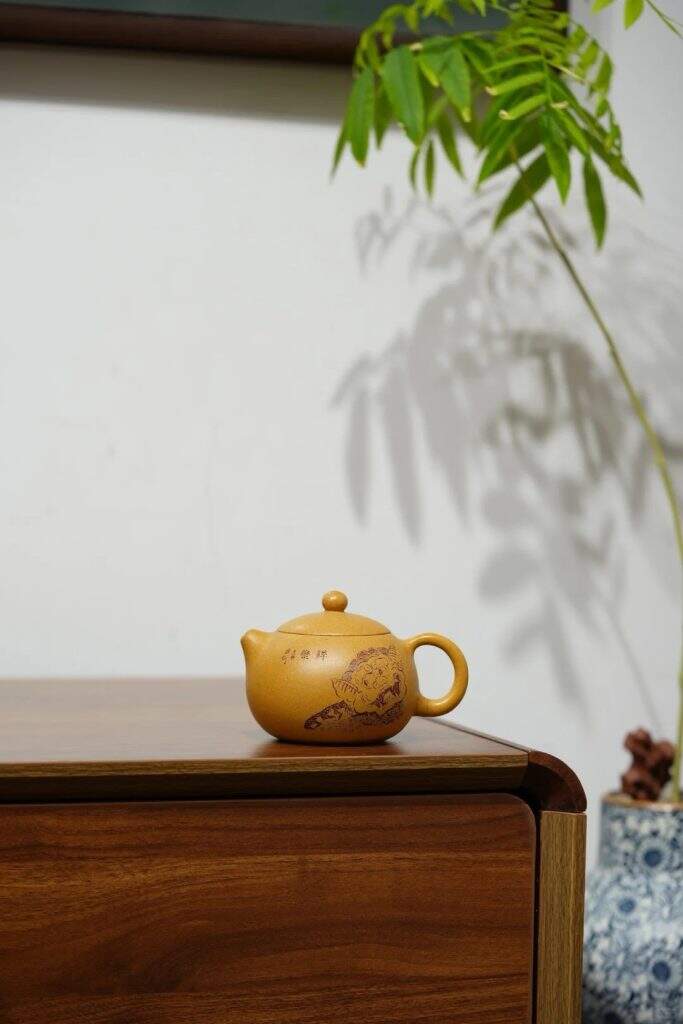The Timeless Elegance of Yixing Xishi Teapot: A Collector’s Guide to Craftsmanship and Culture
For tea connoisseurs and art collectors alike, the Yixing Xishi Teapot (西施壶) represents the pinnacle of Chinese zisha (purple clay) craftsmanship. Named after one of ancient China’s legendary “Four Great Beauties,” this teapot seamlessly blends artistic allure with functional excellence. In this guide, we’ll explore its origins, design philosophy, meticulous production process, and enduring value as a cultural heirloom.
Birthplace: The Clay Capital of Yixing
Nestled in Jiangsu Province, the city of Yixing (宜兴) has been synonymous with zisha pottery since the Ming Dynasty (1368–1644). Known as the “Pottery Capital of China,” its unique mineral-rich purple clay (zisha) deposits—composed of iron, quartz, and mica—are found nowhere else on Earth. This clay’s exceptional porosity allows teapots to “season” over time, absorbing tea oils to enhance flavor with each brew.
Yixing artisans have honed their craft for centuries, passing down techniques through generations. Today, the city remains the epicenter of zisha artistry, with the Xishi Teapot standing as one of its most iconic creations.
Legend and History: A Teapot Inspired by Beauty
The Xishi Teapot draws its name and design from Xi Shi (西施), a revered beauty of the Spring and Autumn Period (770–476 BCE). Legend says the teapot’s curves mirror her graceful silhouette—its rounded body symbolizing feminine elegance, while the short spout and handle evoke simplicity and balance.
While the exact origins of the Xishi design are debated, it gained prominence during the Qing Dynasty (1644–1912). Scholars and tea masters prized it not only for its aesthetics but also for its ability to brew delicate teas like green and oolong without overpowering their aromas.
Design Philosophy: Harmony in Form and Function
The Xishi Teapot’s design adheres to the Taoist principle of “unity between human and nature” (天人合一). Its minimalist, curvaceous form eliminates sharp angles, promoting a smooth flow of tea and heat retention. Key features include:
Bulbous Body: Maximizes water circulation for even steeping.
Inverted Handle: Ergonomically designed for a secure grip.
Short Spout: Ensures precise pouring without dripping.
Flat Lid: Often adorned with a decorative knob, symbolizing harmony.
This design isn’t merely aesthetic—it’s engineered to elevate the tea-drinking experience.
Artisanal Craftsmanship: A Labor of Love
Creating a genuine Yixing Xishi Teapot is a 30-step process demanding skill, patience, and reverence for tradition:
Clay Selection: Artisans handpick zisha clay, sorting it into three types: zini (purple), hongni (red), and lüni (green). Each offers unique textures and thermal properties.
Aging the Clay: Raw clay is sun-dried, then aged for years to enhance plasticity.
Hand-Building: Using age-old techniques like slab construction and wheel-throwing, the teapot is shaped without molds.
Carving and Detailing: Intricate patterns or calligraphy may be etched into the surface.
Firing: Fired in kilns at 1,100–1,200°C, the clay undergoes a molecular transformation, gaining its signature luster.
Only seasoned masters can achieve the Xishi’s flawless proportions and balance—a testament to Yixing’s UNESCO-recognized intangible cultural heritage.
Why Zisha Clay? The Science Behind the Art
Yixing’s zisha clay is a geological marvel. Its high iron content and porous structure:
Neutralize Bitterness: Absorbing tannins for smoother tea.
Retain Heat: Ideal for multiple infusions.
Develop Patina: Over time, the teapot’s interior develops a natural “tea coating” that enriches flavor.
Unlike glazed ceramics, zisha teapots are meant for one type of tea to preserve purity—green tea, oolong, or pu’er each deserves its dedicated Xishi vessel.
Collectible Value: Investing in Heritage
A premium Xishi Teapot is more than a utensil—it’s a appreciating asset. Factors driving its value:
Master Artisans: Pieces by renowned craftsmen (e.g., Gu Jingzhou, Jiang Rong) fetch thousands at auctions.
Antique Authenticity: Qing Dynasty Xishi pots are museum-worthy rarities.
Limited Clay Reserves: Depleting zisha deposits make genuine Yixing wares increasingly scarce.
Collectors also cherish the Xishi’s symbolic meaning—embodying grace, resilience, and China’s tea culture legacy.
Caring for Your Xishi Teapot
To preserve its beauty and functionality:
Season Gradually: Start with light teas before progressing to stronger varieties.
Avoid Soap: Rinse with warm water; let air-dry.
Display with Pride: Protect from direct sunlight to prevent cracking.

A Legacy in Your Hands
The Yixing Xishi Teapot transcends trends, offering a bridge between ancient artistry and modern tea rituals. Whether you’re a tea enthusiast seeking richer flavors or a collector drawn to cultural treasures, this teapot promises a lifetime of sensory pleasure and heritage.
Own a piece of history—explore our curated collection of authentic Xishi Teapots today.










Add comment
You must be logged in to post a comment.